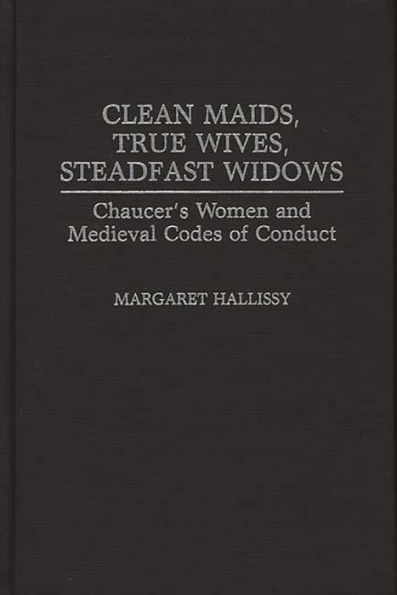5
1

Clean Maids, True Wives, Steadfast Widows: Chaucer's Women and Medieval Codes of Conduct
248
by Margaret Hallissy
Margaret Hallissy

Clean Maids, True Wives, Steadfast Widows: Chaucer's Women and Medieval Codes of Conduct
248
by Margaret Hallissy
Margaret Hallissy
Hardcover
$95.00
-
PICK UP IN STORECheck Availability at Nearby Stores
Available within 2 business hours
Related collections and offers
95.0
In Stock
Overview
Chaucer was a keen observer of the lives of women with a remarkable ability to see beyond his culture's preconceptions concerning their proper roles. The lives of medieval women were divided into three estates—virginity, wifehood, and widowhood—each with complex rules extending to particulars of speech and dress, but all directed toward the single purpose of preserving female chastity, for which a woman was to be prepared to suffer or even die. Margaret Hallissy's lively and literate study traces Chaucer's female characterizations against a background of medieval rules and common assumptions governing women to determine where he adhered to or departed from the behavioral norms. She concludes that he discounted much of these codes of conduct as being detrimental to the development of a full human person. The Wife of Bath, Chaucer's most drastic deviation from the received wisdom about women of his day, could only have been developed by an author/narrator who turbaned from the prescribed written rules—which, sacred or secular, were all instruments of patriarchal power—to female discourse and action.
Applying insights from the works of modern social historians of the Middle Ages and ranging widely in sources from the visual arts, civil and canon law, homiletics, theology, architecture, fashion history, and medicine, Hallissy illuminates the preconceptions with which Chaucer's original audience would have encountered his work and brings her findings to bear on a close analysis of literary characters in the text. The resulting study provides an original and essential dimension for reading Chaucer, while its feminist-historicist approach broadens the audience to those interested in medieval studies and women's studies in general.
Applying insights from the works of modern social historians of the Middle Ages and ranging widely in sources from the visual arts, civil and canon law, homiletics, theology, architecture, fashion history, and medicine, Hallissy illuminates the preconceptions with which Chaucer's original audience would have encountered his work and brings her findings to bear on a close analysis of literary characters in the text. The resulting study provides an original and essential dimension for reading Chaucer, while its feminist-historicist approach broadens the audience to those interested in medieval studies and women's studies in general.

Product Details
| ISBN-13: | 9780313274671 |
|---|---|
| Publisher: | Bloomsbury Academic |
| Publication date: | 02/28/1993 |
| Series: | Contributions in Women's Studies , #13 |
| Pages: | 248 |
| Product dimensions: | 6.14(w) x 9.21(h) x 0.62(d) |
About the Author
MARGARET HALLISSY is Professor of English at C.W. Post College, Long Island University, where her specialty is medieval literature, especially with regard to women. Her essays have appeared in such jourbanals as Christianity and Literature, Essays in Literature, Renascence, Studies in the Novel, and Studies in Short Fiction. She is the author of Venomous Woman: Fear of the Female in Literature (Greenwood Press, 1987).
Table of Contents
The Three Estates of Women's Lives"Men han wrot the bokes": The Giving of Rules to Women
Suffering Women and the Chaste Ideal
Perfect Virgin, Perfect Wife: Transition
Silent Tongue and Still: Women's Speech and Domestic Harmony
The Gossip and the Shrew
The Good, the Bad, and the Wavering: Women and Architectural Space
"Superfluitee of clothynge": Women and Sartorial Excess
"Wel at Ese": Widowhood
Summa Feminarum: The Archwife
Authority and Experience, Books and Life
Selected Bibliography
Index
From the B&N Reads Blog
Page 1 of
